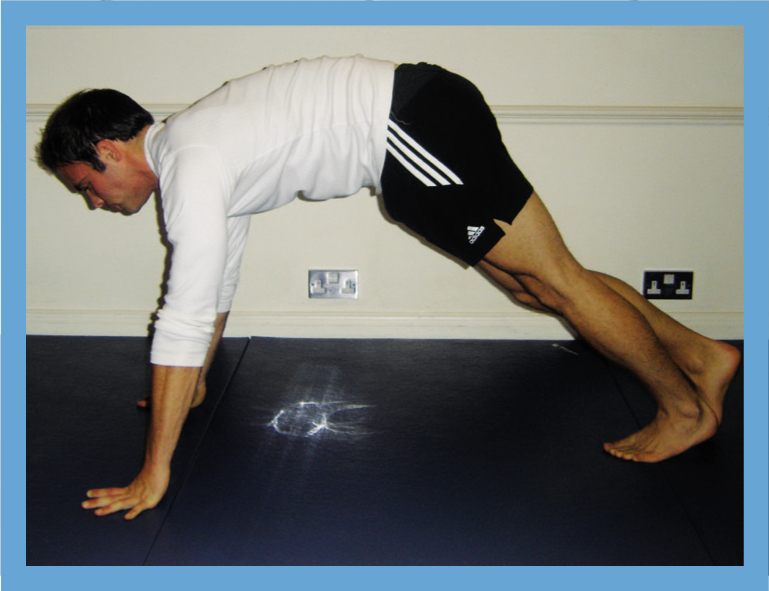
08 RELEASE THE PRESSURE
MASSAGE AND STRETCHING
Massage is one of the oldest and simplest forms of medical care used to ease pain and anxiety, and to promote good health. Massage therapy and stretching provides relaxation and relief to muscle strain and fatigue, and this contributes to our overall health and well-being.
The benefits of massage therapy are almost endless, and include physical, emotional and physiological improvements to the body.
During the 12-week programme it is worth considering having massages to help relieve muscular spasms and tension, aid in the breaking down of cellulite, boost the immune system and stimulate the lymphatic system.
MUSCULAR MASSAGE
Uses pressure or trigger points and essential oils to work with massage to eliminate pain patterns. This approach ultimately brings balance between the musculoskeletal system and the nervous system.
LYMPHATIC MASSAGE
Features special pumping strokes and vibrations to enhance the flow of the lymphatic system. Lymph is a whitish coloured liquid that flows throughout the body inside lymph vessels, which collect waste and toxins that cannot be absorbed through the capillary blood vessels. The combined movement and pressure encourages the movement of lymphatic fluid. This helps the immune and lymph systems, plus any other types of oedema, to return to full health and correct working order.
MYO STRETCHING ROUTINE
Throughout the 12-week programme I used the myo stretch, which is an hour-long stretching routine. The myo stretch encompasses and works the majority of the muscles within your body to ensure an increase in muscle strength and resistance.
There are multiple benefits to stretching, and it should not be overlooked in your daily health routine. When we stretch properly we:
•Increase our range of motion (ROM)
•Increase performance in training and exercise (power and strength)
•Improve posture
•Reduce fatigue within muscles
•Reduce any delayed onset of muscle soreness after training or exercise (DOMS)
•Develop body awareness
•Promote circulation
•Improve relaxation within tense and tight muscles
•Aids stress relief
HOW TO STRETCH CORRECTLY
There is no time limit to stretching, although do remember that less is best. The gentler you are with your stretching, the more you get out of the muscles. When you find the first part of tension in your stretch, you should feel a really small amount, as if you are just about to stretch. It should be nice and simple, and isolate the muscle you are trying to focus on without involving any others. Allow the muscle adequate time to relax and elongate (there is no time limit).
If you are bouncing in stretches, feeling sharp pain in the muscle being stretched, feeling muscle spasm or shake, or feeling a burning sensation, then you are probably stretching the muscle too hard, and most likely incorrectly. Remember, less is best.
There are different types of stretching that can improve flexibility and strength, and are an important element when creating harmony within your body.
Static stretching
This means performing a certain stretch without movement. This is when you find the first tension within the muscle and hold, without moving from that position. Once it has released, you can either move on to the next stretch or gently repeat the action.
Developmental stretching
This works in the same way at the static stretch. You find the first point of tension and hold it until the muscle relaxes and elongates. Once you feel no stretch, go slightly further into the stretch until you feel tension for the second time. Repeat up to four times.
Proprioceptive neuromuscular facilitation stretching (PNF)
An advanced stretching and flexibility technique that involves both the contraction and stretching of a muscle. This stretch is best performed with a professional or training partner, although some can be tried at home. Always remember to listen to your body and take note on how to perform the PNF correctly, and do not use the PNF stretch on muscles that are weak, elongated or overstretched.
To perform PNF stretching:
•Find the first bit of tension in the stretch and hold until the tension has elongated.
•Contract the same muscle that was being stretched for 20–40 per cent of your maximum effort.
•Hold the contraction of the muscle for 12 seconds.
•Release the contraction and allow the muscle to relax for a second.
•Now find the second stretch by going further until you find the tension again. You should have noticed a greater range before feeling the stretch.
•Again, allow the stretch to relax and elongate before repeating the process.
•You can repeat this process up to three times before coming out of the stretch.
MYO STRETCH
Developmental stretch for calf (gastrocnemius) muscles

•From a press-up position, move your hand closer to your feet while raising your hips into the air.
•With your feet together, use one foot for support with the other foot flat on the floor and your legs extended straight, but not completely locked out.
•Bend the leg that is for support.
•Move your hands closer until you feel a small stretch in the calf of the foot that is flat to the ground.
•Once the stretch has elongated, move your hands closer again to your feet, or you can push your heel into the floor. You should now be feeling a stretch in the middle part of your calf muscle.
•Without dropping the position, allow your hands to go back to the starting position and repeat for the other leg. You will also be working your upper body while in this position.
•Once you have completed the stretch on the other side, move your hands back to the start, keeping in the same position. You are now ready to perform the soleus stretch.
Developmental stretch for soleus muscles
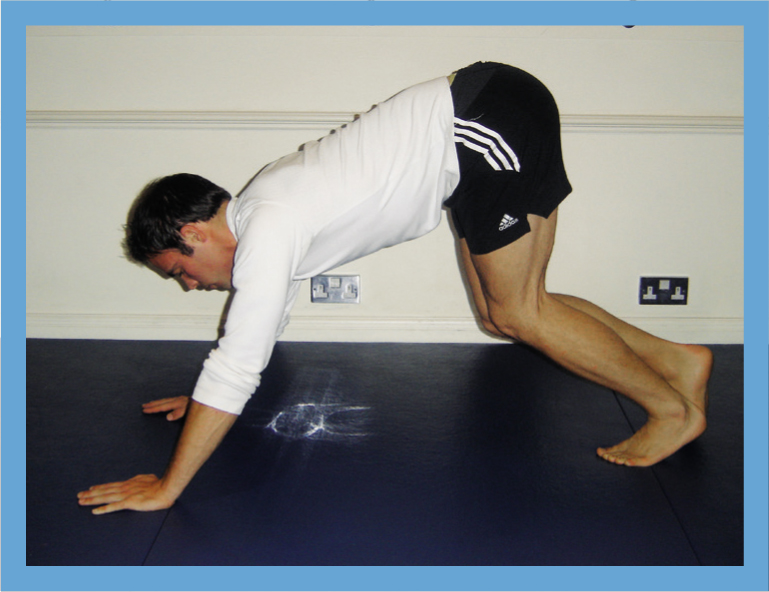
•Stay in the position of the calf stretch – with your hands out in front of you and your hips in the air.
•With your feet together, use one for support and the other almost flat on the floor, legs bent at the knee.
•Move your hands closer until you feel a small stretch in the lower calf.
•Once the stretch has elongated, move your hands closer to your feet, or you can push your heel into the floor. You should be feeling a stretch on the lower calf towards your Achilles tendon.
•Without dropping the position, allow your hands to go back to the starting position and repeat for the other leg. You will also be working your upper body while in this position.
•Once you have completed the stretch on the other side, put both feet on the floor and go back down into the press-up position.
•Sit up and sit back on to your heels. You are now ready to move on to the lower back stretch.
Static stretch for the lower back
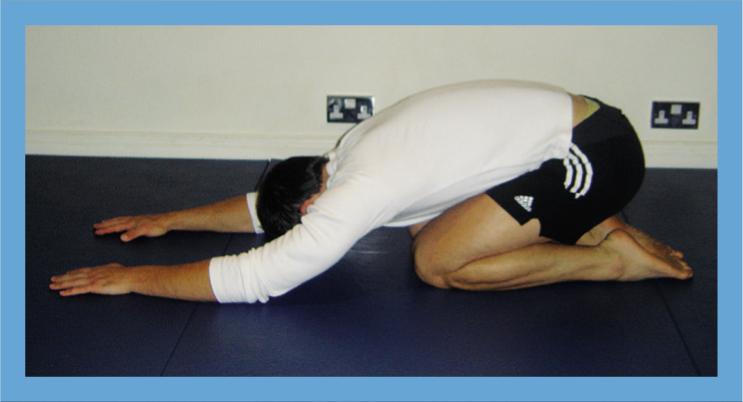
•While sitting on your heels, reach forwards from your hip with your hands out in front of you and let your head relax.
•You should be nice and relaxed, and you might be able to feel a stretch in your lower back and latissimus dorsi.
Developmental stretch for hip flexor stretch
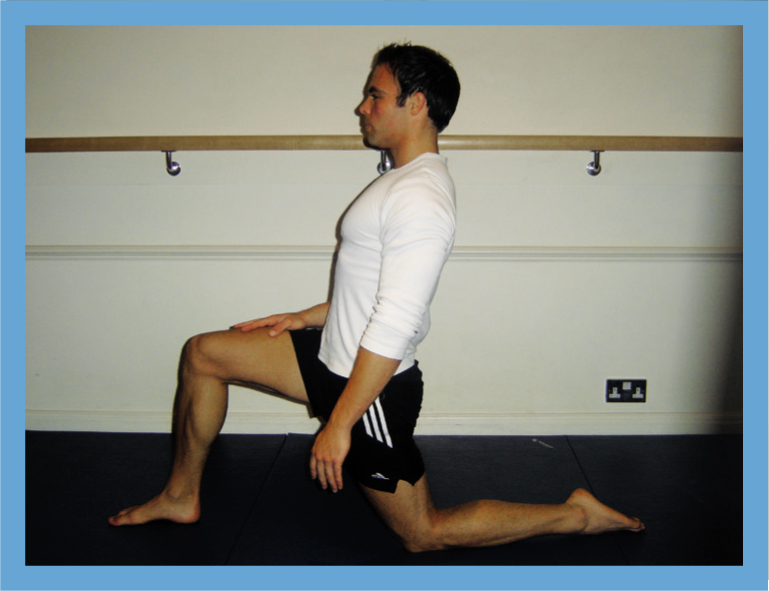
This is a good stretch for a lordotic posture:
•Kneel on one foot.
•If you need to, hold on to an object to help keep balance.
•Lean slightly forwards so your weight is on the front foot.
•Push your hip out forwards.
•To get more of a stretch, lean your torso slightly back in the opposite direction. You should feel a stretch in the front of your hip (iliacus, psoas major and rectus femoris).
•From this position go straight into the PNF stretch on the same leg.
PNF stretch for hamstring muscles
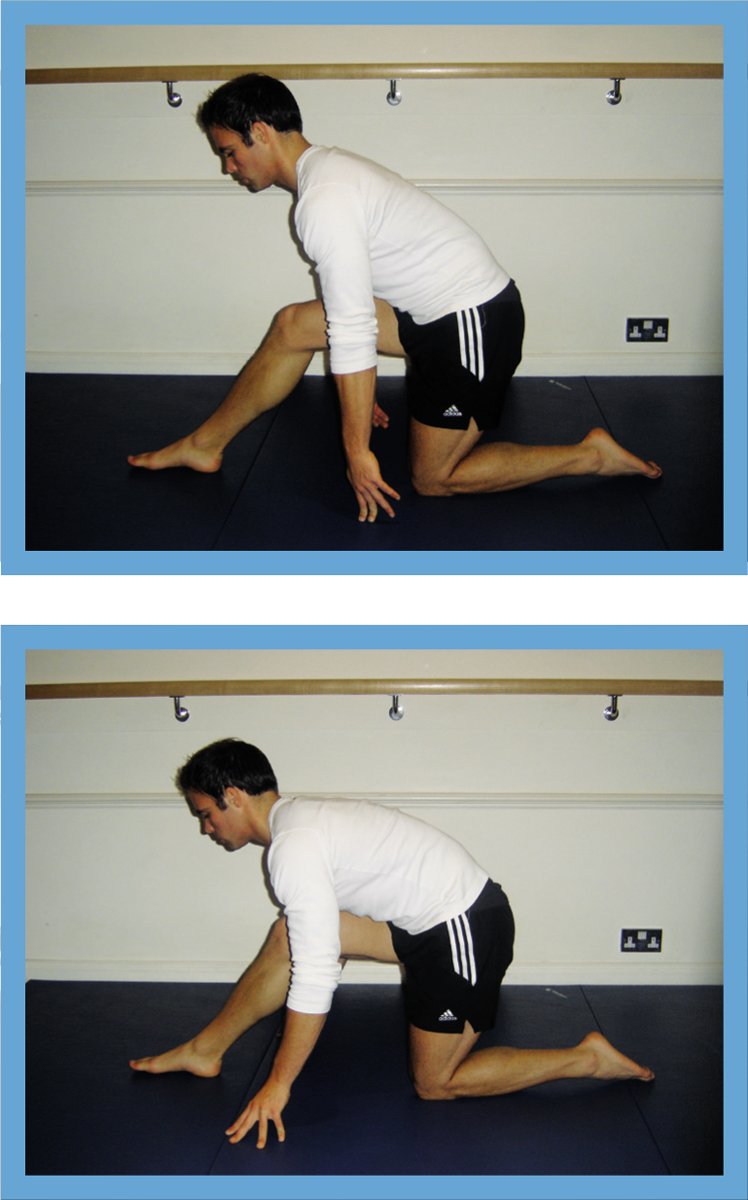
This is a postural stretch for flat back/sway back:
•Kneel on one knee with your other leg out in front, so your foot is flat on the floor.
•Keep your back straight while leaning forwards to keep balance (you can either balance yourself with one or both arms down to the floor).
•Sit back on to your knee.
•Try to keep your leg out in front, with a small bend in your knee.
•Tilt your buttocks up in the air to feel more of a stretch. As long as you have the stretch in your hamstrings you can now perform a PNF stretch if your muscle requires it.
•Follow the rules for performing a PNF stretch.
•While in the same position, and now that the first stretch has released, you can push your foot into the ground as if you were trying to curl your heel up to your bum. You should now feel the same muscle contract that was just being stretched (if you can’t feel the contraction in your hamstring, try moving until you do feel it).
•Hold the contraction at 20 per cent of your maximum effort for 12 seconds.
•Relax for one second, and then move into the stretch for a second time.
•Perform the PNF stretch two or three times. You should feel a stretch in the back of your thigh/hamstring (semimembranosus, semitendinosus and biceps femoris).
•Sit back on to both of your heels.
•Now change legs and repeat these last two stretches.
Static stretch for the lower back
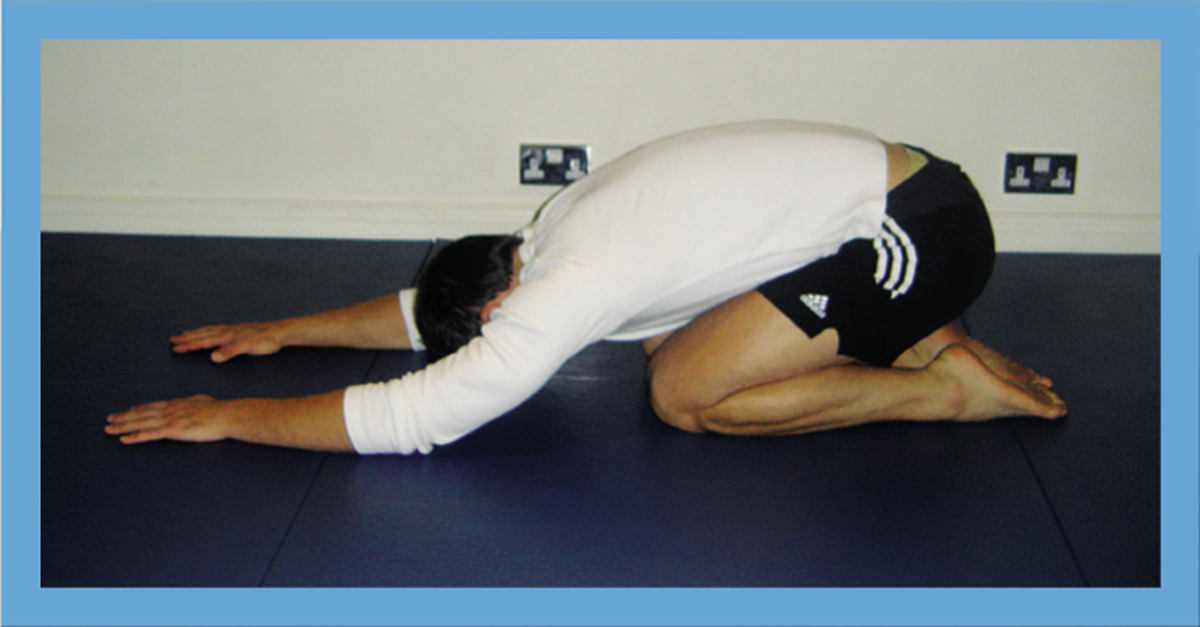
•While sitting on your heels, reach forwards from your hip with your hands out in front of you and let your head relax.
•You should be nice and relaxed, and you might be able to feel a stretch in your lower back and latissimus dorsi.
•Sit back up on to your heels.
Developmental stretch for quad with your knees bent

•While sitting on your heels, place your legs under your buttocks.
•Lean back, keeping your body weight on your arms.
•You should then be able to feel a stretch in the middle part of your quads.
•To feel more of a stretch, or to develop the stretch, move your hands further behind you or squeeze your glute muscles/push out your hips. You should be able to feel a stretch within the middle part of your quads (rectus femoris, vastus medialis, vastus lateralis and vastus intermedius).
•Roll over on to your front and lie face down.
PNF stretch for quad lying face down
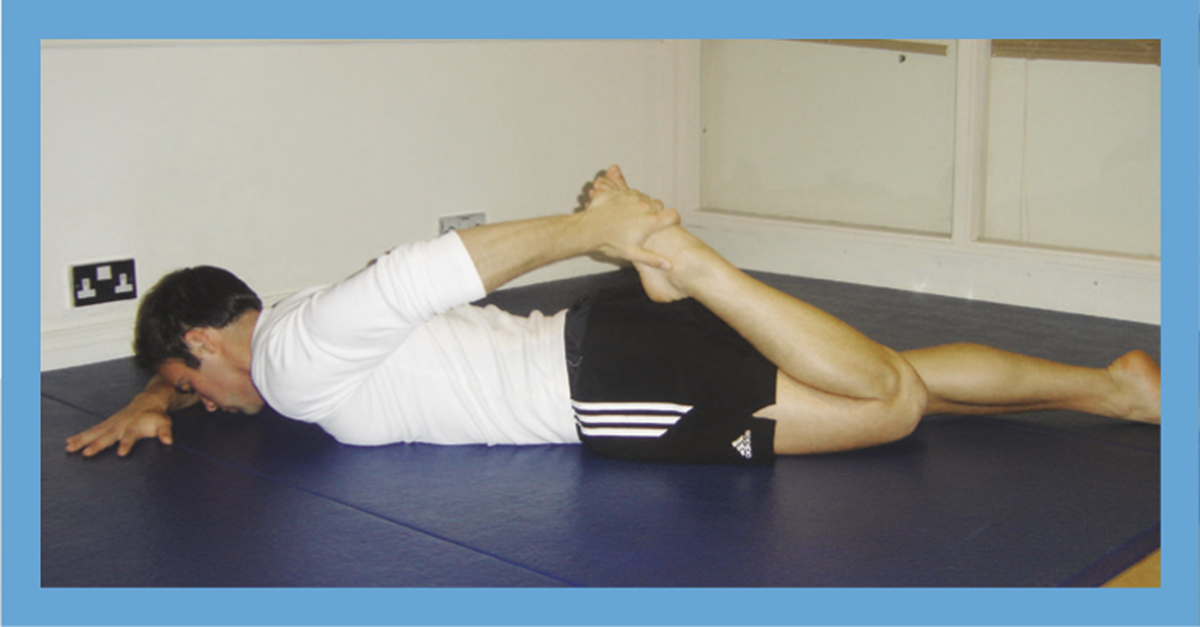
This is a posture stretch for lordotic postures.
•Lie face down.
•Bring one foot up towards your buttock while holding on to it with the same-side arm.
•Pull the foot to your buttock to feel the stretch within the middle/upper part of the quad.
•As long as you have the stretch in your quads you can now perform a PNF stretch if your muscle requires it. Follow the rules for performing a PNF stretch.
•While in the same position, and when the first stretch has released, you can push your leg out as if you are trying to straighten it. You should now feel the same muscle contract. (If you can’t, try to move slightly until you feel the muscle contract.)
•Hold the contraction at 20 per cent of your maximum effort for 12 seconds.
•Relax for one second, and then move into the stretch for a second time.
•Perform the PNF stretch two or three times.
•You should be able to feel a stretch within the middle to upper portion of the quads (rectus femoris, vastus medialis, vastus lateralis and vastus intermedius).
•Once you have stretched your quad, swap your hands over so your opposite hand is on the leg being stretched.
•From this position, go straight into the static stretch for the quads on the same leg.
Static stretch for quad muscles lying down, opposite hand to opposite leg
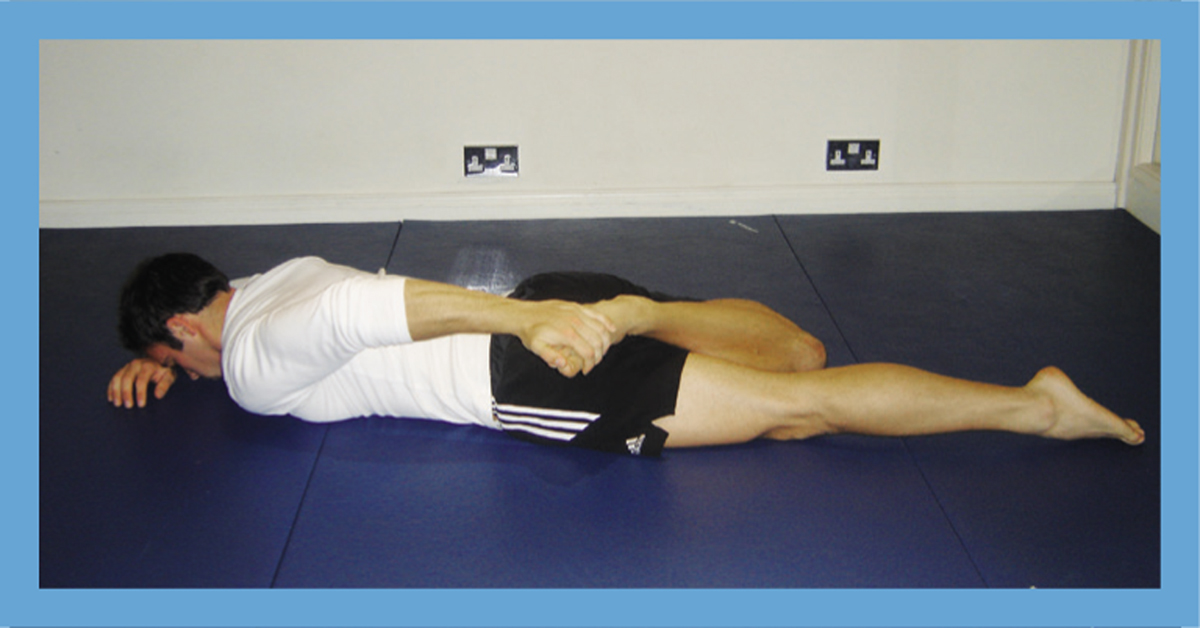
•Lie face down.
•Bring one foot up towards your buttock, while holding on to it with the opposite arm.
•Pull the foot to your opposite buttock.
•Keep your hips on the ground. You should be able to feel a stretch on the outer part of the quad).
•Once you have finished stretching, move on to your other leg and repeat.
•Once you have finished your lying quad stretches you can relax for 1 or 2 minutes in this position.
•Roll on to your back and sit up for your hamstring stretch.
•Repeat these last two stretches on the other leg.
Developmental stretch for sitting hamstring muscles
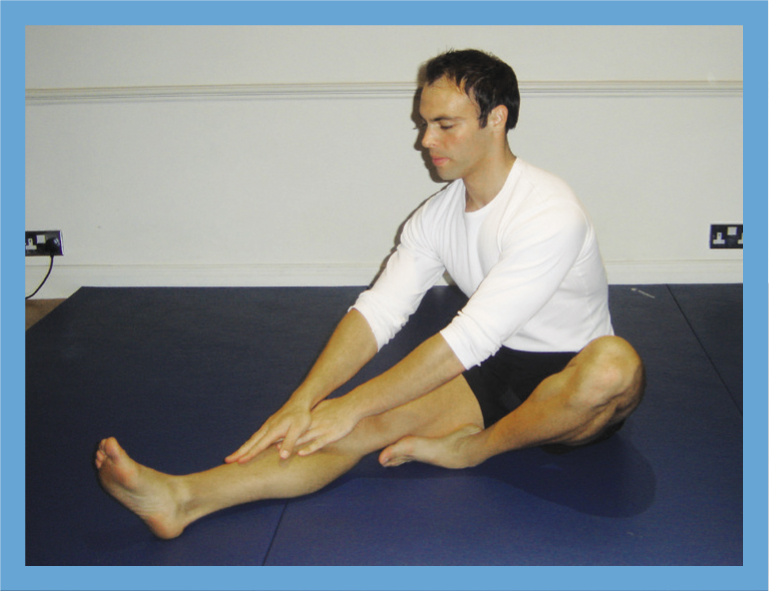
This is a posture stretch for flat back or sway back.
•Place your arms on the ground beside you.
•Place both legs out in front of you.
•Sit with your back straight.
•Bend one knee enough so it falls to the side, while keeping your other leg straight.
•Lean forwards from the hip until you find a stretch in your hamstrings. You should now be able to feel a stretch within your hamstring muscles (semimembranosus, semitendinosus and biceps femoris).
•Once you have stretched one side, move on to the other side.
•When you have finished stretching your other leg, keep both legs out in front of you ready for the next stretch.
Developmental stretch for the wide leg adductor
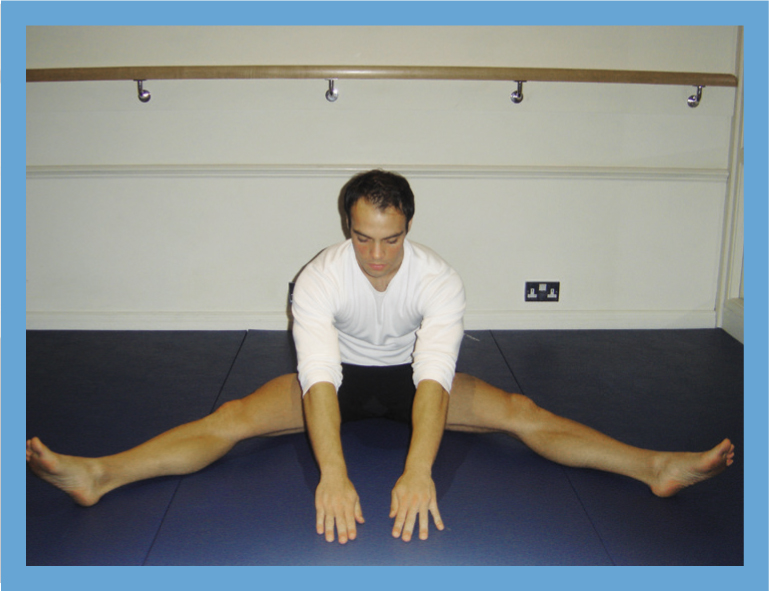
•Sit with your legs straight out and wide in front of you (make sure it is as wide as is comfortable so that you don’t feel a stretch on your hamstring muscles).
•Sit with a straight back.
•Lean forwards until you feel a stretch on your adductors. You should be able to feel the inside of your thighs/adductors (adductor longus, adductor brevis, adductor magnus and gracilis).
•Bring both feet into your groin, if possible with your feet together, to stretch adductors.
Developmental stretch for the sitting groin muscle
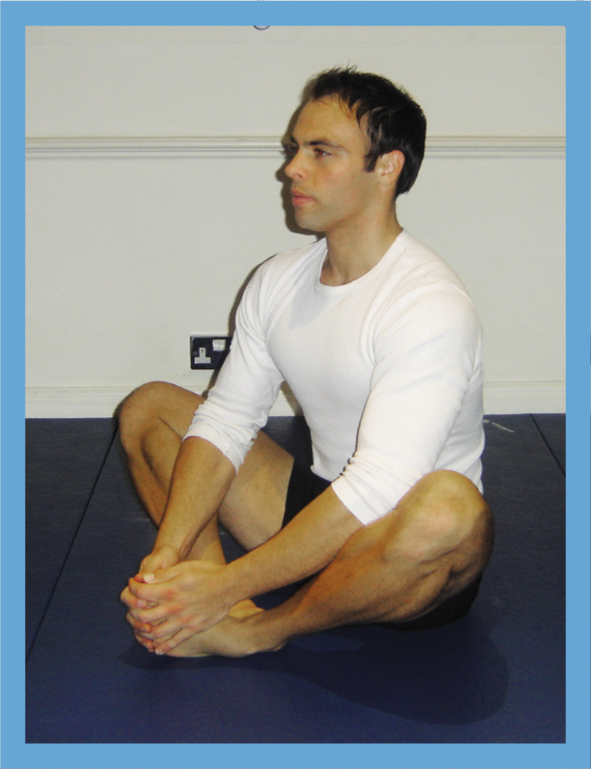
•Sit with your back straight.
•For support, hold on to your feet.
•Keep your feet together if possible, and allow your knees to drop out to the side.
•You should feel a stretch on the inside of your thighs. If not, bring your feet in towards your groin.
•You should be able to feel a stretch on the inside of your thighs/adductors (adductor longus, adductor brevis, adductor magnus, gracilis and pectineus).
•Put both of your legs out in front of you and relax your body for one or two minutes.
Static stretch for sitting glute muscle extensions
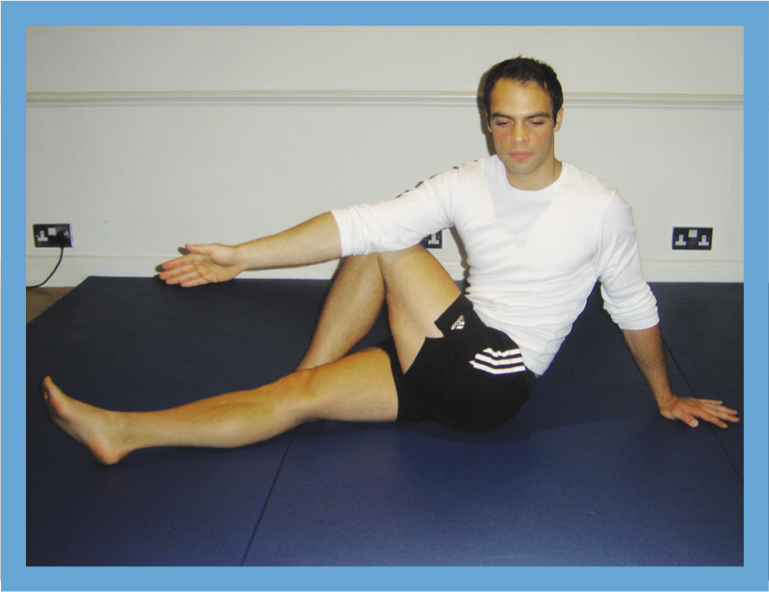
Perform this stretch if you feel pain in your lower back.
•Sit with one leg out straight, and cross the other leg over your knee.
•Turn your shoulders around so your torso is facing away from your body.
•Place one arm on to your raised knee to help you rotate even further, and your other arm out behind you to support yourself. You should be able to feel a stretch in your glute muscles (gluteus maximus, gluteus medius and gluteus minimus), as well as tensor fasciae latae and piriformis.
•Swap your legs over to stretch your other side.
•Keep your leg crossed but relaxed. Roll on to your back to stretch your deeper glute muscles.
•Change your legs over and repeat the same stretch.
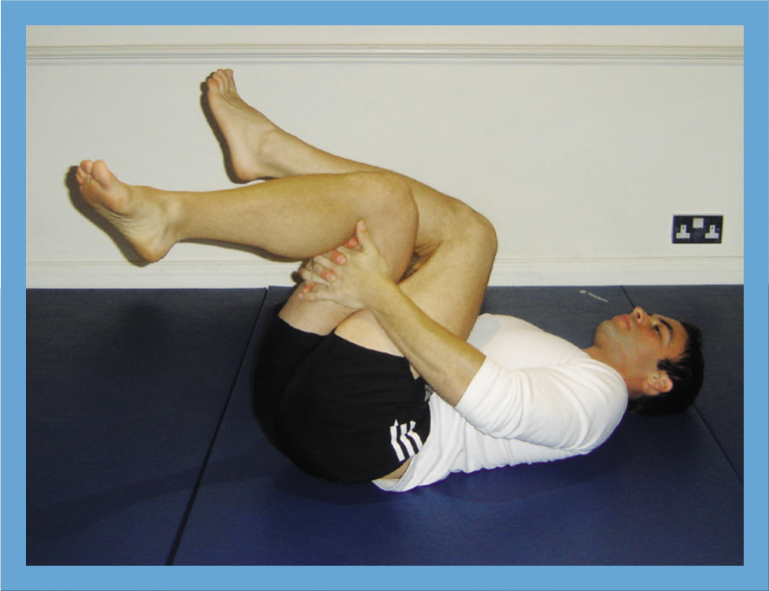
Developmental stretch for glute muscles
Perform this postural stretch when suffering from sciatica (caused by your piriformis being too tight).
•Lie on your back on the floor, face up.
•Cross one leg over the other.
•Start to bring your foot down towards your buttock.
•Grasp on to the thigh (hamstrings) just under the knee.
•Pull the leg up and towards your chest. You should be able to feel a stretch in your glute muscles (piriformis, deep glute muscles and gluteus maximus).
•Stretch the other side, then relax with your feet on the ground and your knees in the air.
•Bring both knees into your chest to stretch your lower back.
•Change your legs over and repeat the stretch on the other side.
Developmental stretch for the lower back while lying down
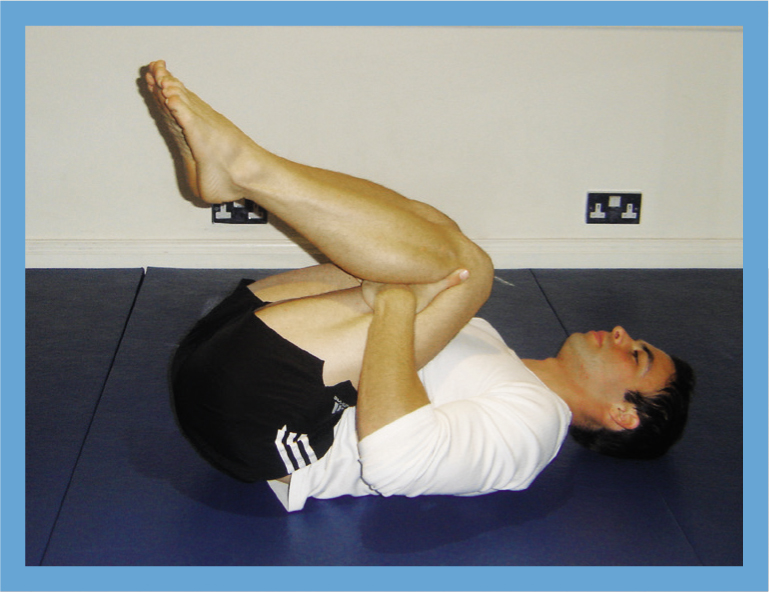
Perform this postural stretch if you have a lordotic posture.
•Lie on your back, face up.
•Hold on to the back of both of your thighs, just underneath the knees.
•Pull your knees towards your chest, allowing your buttocks to rise off the ground. You should be able to feel a stretch in your lower back and gluteus maximus.
•Once the stretch has released, drop your feet on to the floor with knees bent and relaxed.
•Drop legs flat to the floor for the next stretch.
Static stretch for the whole body
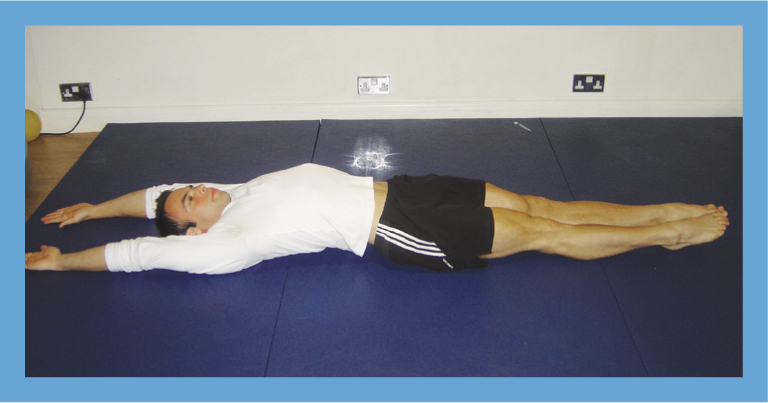
•Lie on your back and extend your legs out straight in front of you, and your arms out straight overhead.
•Lengthen your body as much as possible by pointing your toes and pushing your arms overhead. You should be able to feel a stretch in different places of the body (including your abs, serratus anterior and lattisimus dorsi).
•Once the stretch has relaxed, bring your arms out to your side for the next stretch.
Static stretch for lying roll over
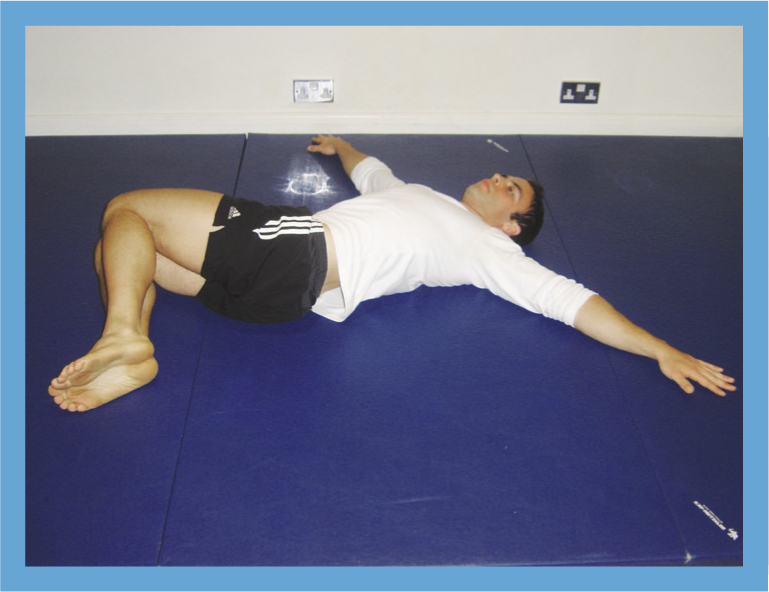
•Lie on your back.
•Keep your arms out to your side and bring your knees up, with your feet on the floor.
•Allow your knees to drop to one side and try to relax your back and hips to get the best stretch. You should be able to feel a stretch in your lower back muscles and glute muscles.
•Bring your knee back up to the centre and drop to the other side.
•Stay on your back in a relaxed position, and relax for 2–3 minutes.
•Roll on to your front for the abdominal stretch.
Static stretch for the abdominal muscles
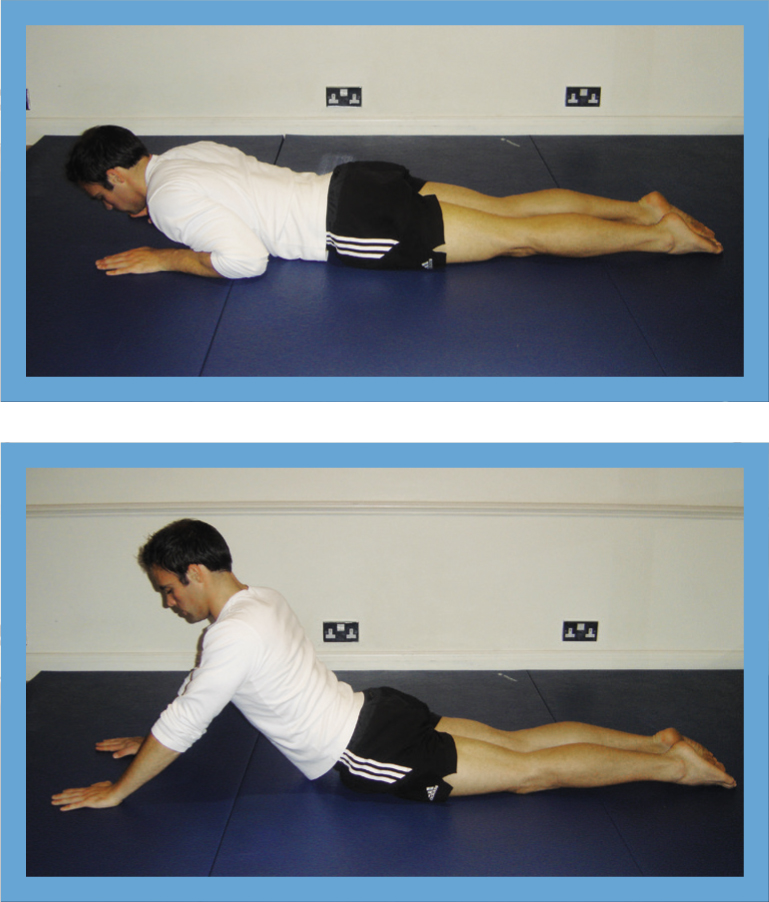
This is a postural stretch for a flat back.
•Lie face down on the floor.
•Keep your hands in front of you, about shoulder-width apart.
•Keep your hips, legs and feet flat on the ground.
•Raise your torso off the ground until your arms are almost straight, or you feel a stretch in your abdominals.
•Hold this stretch for no longer than 10 seconds.
Static stretch for the oblique muscles
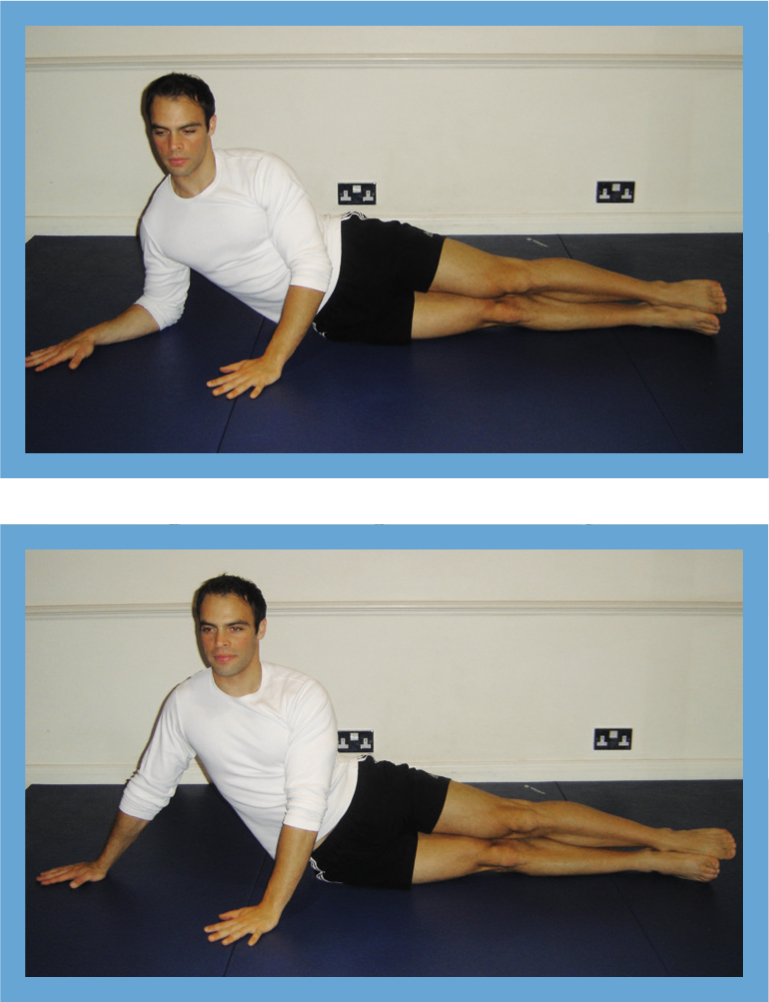
•Lie on your side, keeping your body straight.
•Make sure the leg you’re resting is touching the floor.
•With your forearm resting on the floor and your other arm in front of you for support, extend your resting arm out straight so your body weight is resting on your hand instead.
•You should now feel a stretch on your side and in your oblique muscles.
•Roll on to your front, and then on to the other side, to stretch your other obliques.
•Once you have stretched your other side, roll back on to your front for the cat stretch.
Static cat stretch
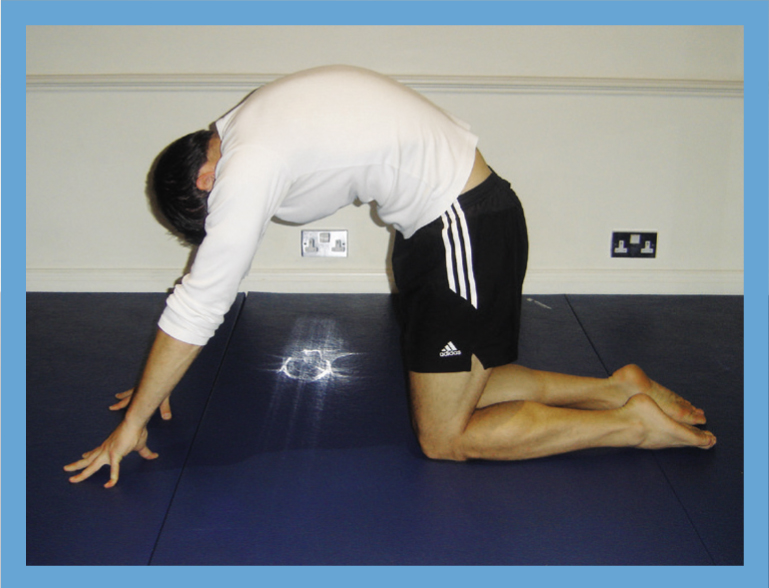
•Kneel on all fours.
•Let your head fall forwards and relax.
•Arch your back and draw in your belly button. You should be able to feel a stretch in your lower back.
•Relax from your stretch, and then sit back on your heels for another lower back stretch.
Static stretch for the lower back
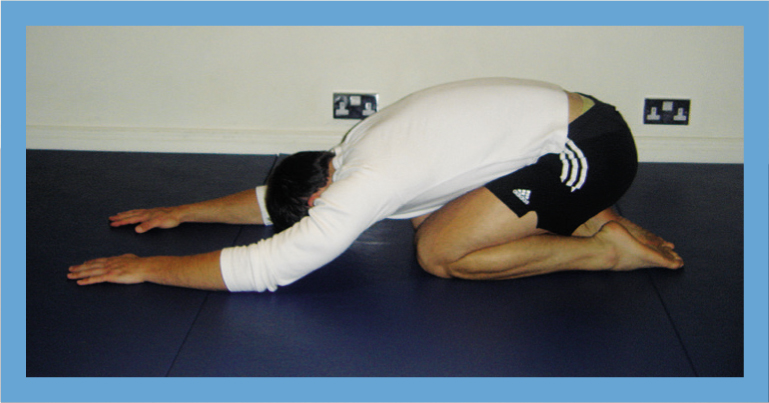
•While sitting on your heels, reach forwards from your hip with your hands out in front of you and let your head relax. You should be nice and relaxed, and you might be able to feel a stretch in your lower back and latissimus dorsi.
•Stay in this position, you’re ready to get on to the next stretch.
Development lat stretch on the floor
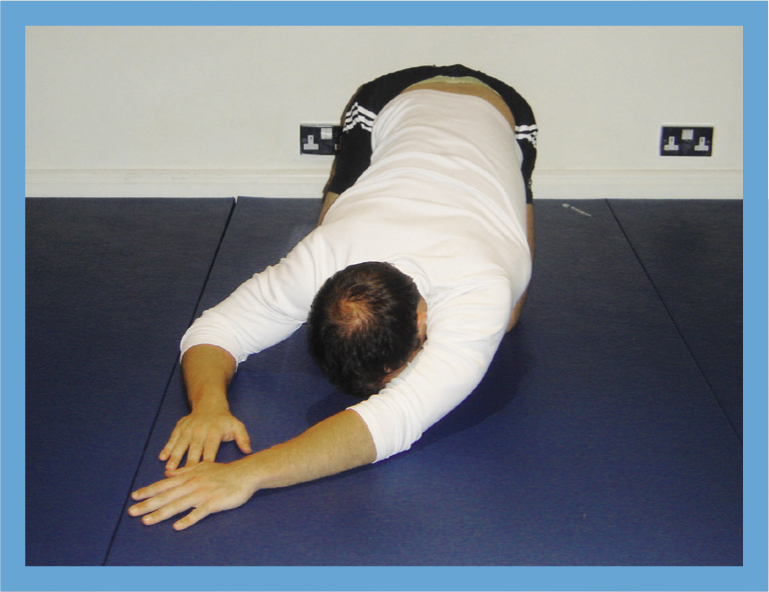
•Sitting on your heels, reach forwards with your hands.
•Place one arm across your body with it resting on the floor.
•Use your fingers to walk your arm diagonally away from your body to feel a stretch in your latissimus dorsi.
•Keep walking your fingers out to get a developmental stretch.
•Bring your arm back to the centre, and then swap over to the other side.
Static stretch for the biceps muscles
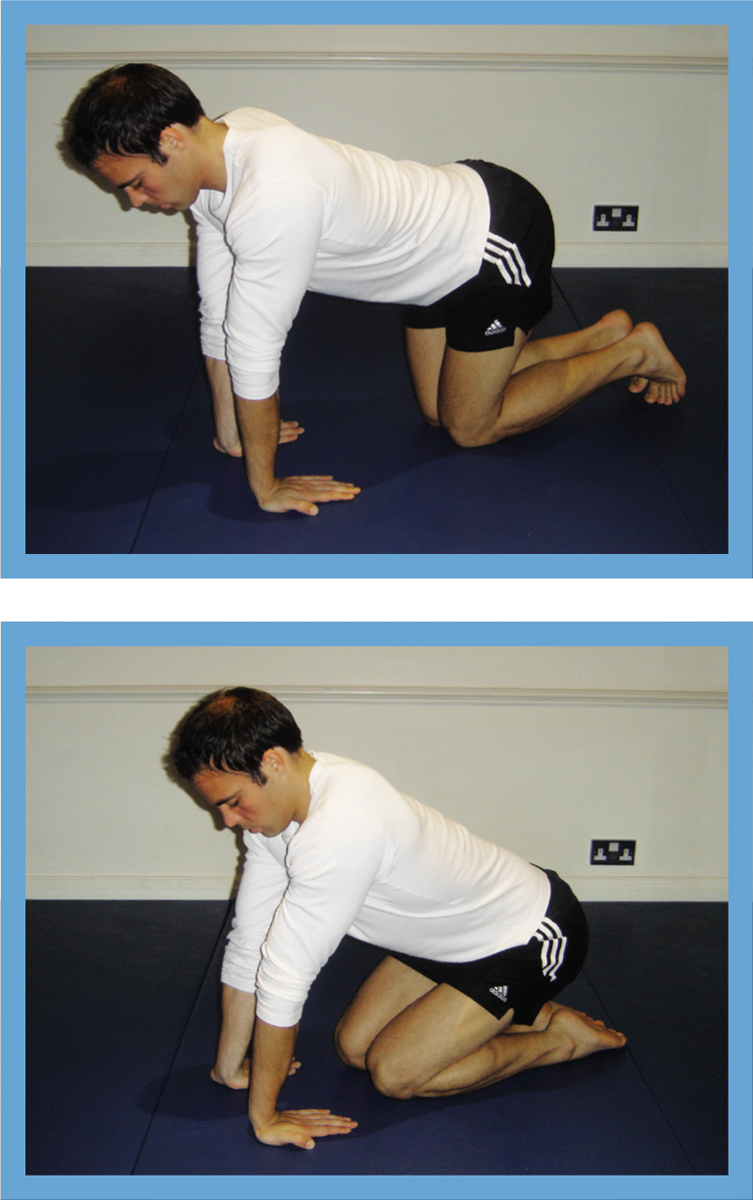
•Kneel on all fours.
•Turn your arms so the insides of your forearms are facing away from you, and your fingers are pointing at you.
•Keep your arms straight, and sit back towards your heels.
•Try not to put too much body weight on to your arms. You should feel a stretch on the front of the top of your arms (the biceps, and possibly on your wrist flexors).
•Sit back up on to your heels, and relax for 2–3 minutes.
Static stretch for the triceps muscles
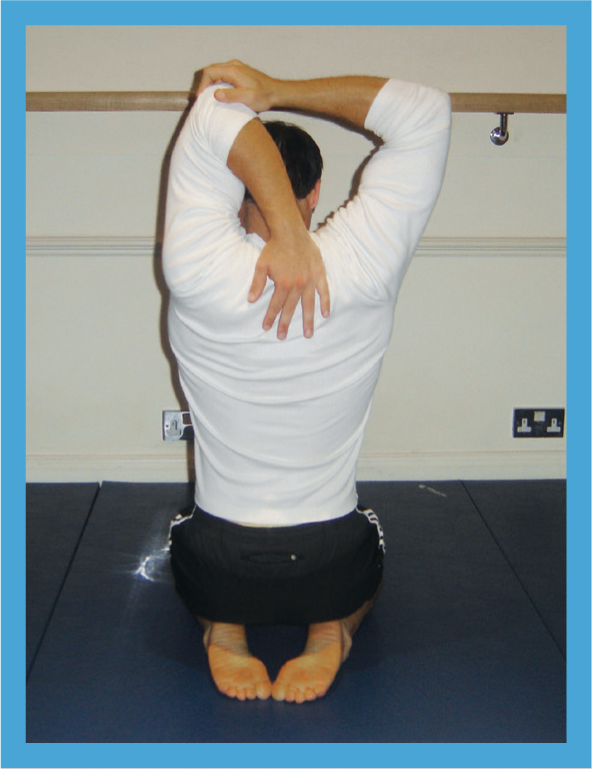
•Sit on your heels.
•Place one hand up and behind your head, with your elbow pointing upwards.
•With your other hand (depending on your flexibility), either pull the elbow down from the top, or you can push the elbow from the front. You should be able to feel a stretch on the back of your upper arm (triceps).
•Now stand up for the final stretches – you can move around to get the blood flowing around your muscles.
•Follow the next stretches one after the other while standing.
Static stretch for wrist flexor muscles
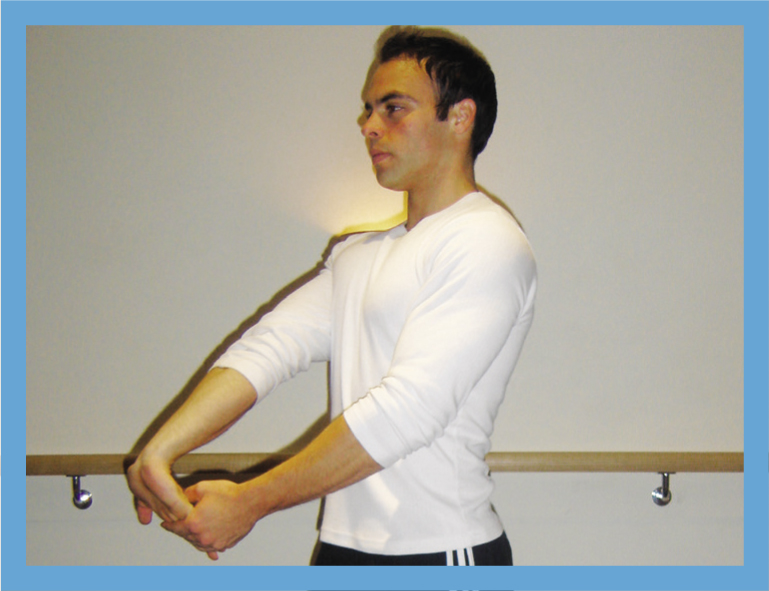
•With one hand, hold on to the fingers of your other hand and straighten your arm so your forearm is facing upwards.
•Pull your fingers/hand towards your body. You should be able to feel a stretch on the inside of your forearm.
•Repeat this stretch on your other hand.
Static stretch for the wrist extensor muscles
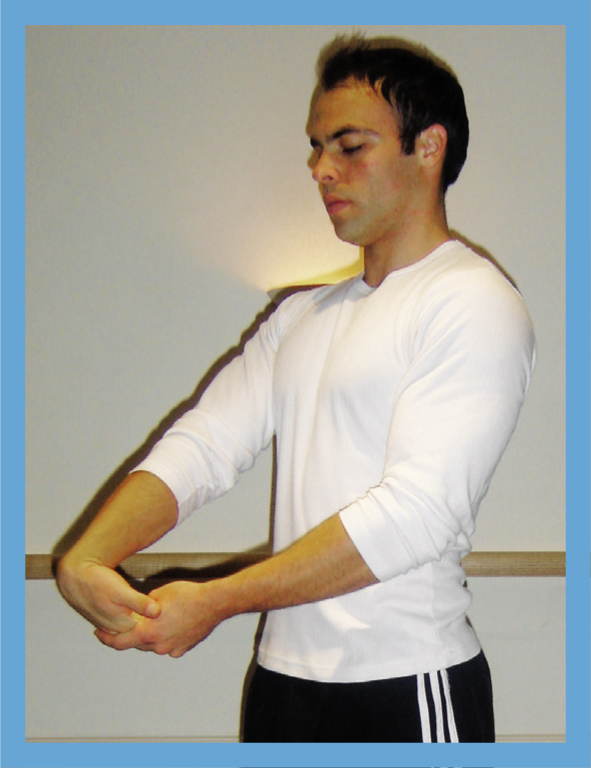
•With one hand, hold on to the opposite fingers/hand and straighten your arm so your forearm is facing down.
•Pull your fingers/hand towards your body. You should be able to feel a stretch on the back of your forearm.
•Repeat this stretch on your other hand.
Static stretch for the anterior deltoid muscles
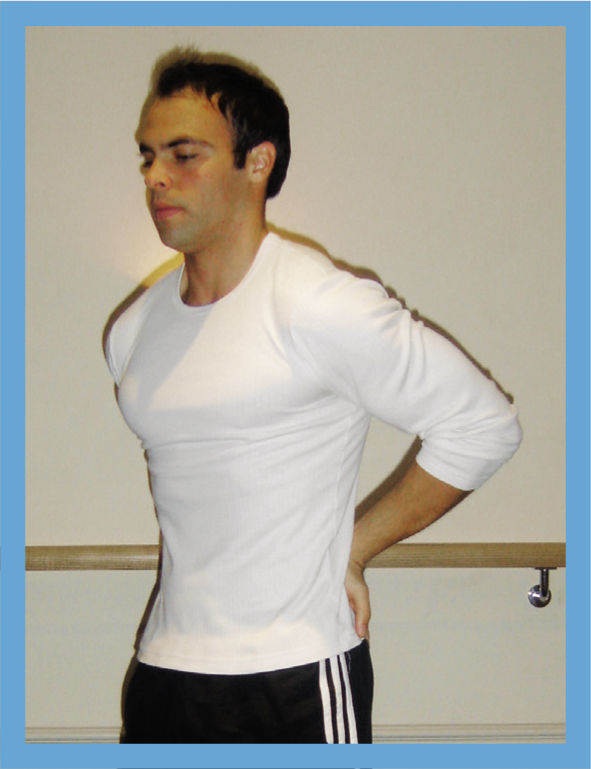
•Place your hands into the base of your back.
•Drop your shoulders forwards and raise up your chest, as if you’re taking in a deep breathe. You should be able to feel a stretch at the front of your shoulders (anterior deltoid).
Static stretch for the deltoid muscles
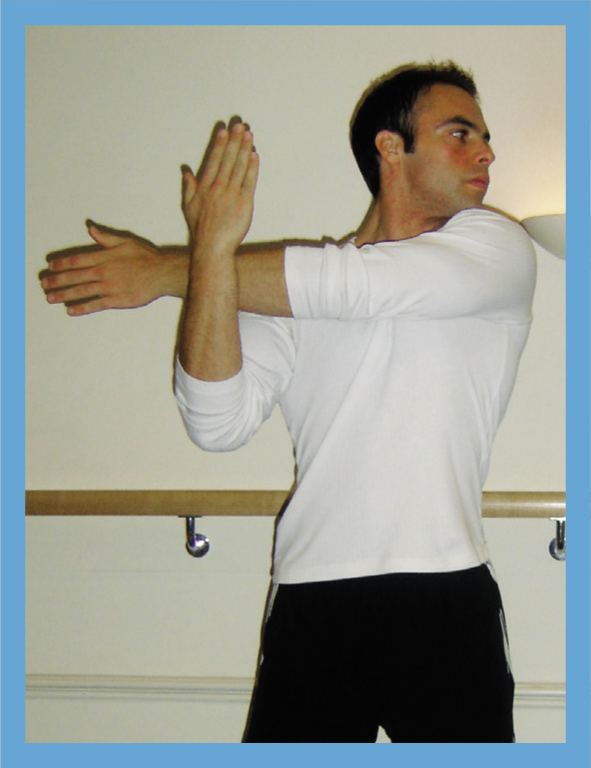
•Place one arm across the front of your body.
•You can either keep that arm straight or you can bend it to a 90° angle.
•Pull your arm in and towards the opposite arm until you feel a stretch. You should be able to feel a stretch in your shoulder, and slightly in the upper back (rear deltoid, rhomboids and trapezius).
Static stretch for the chest with hands behind the back
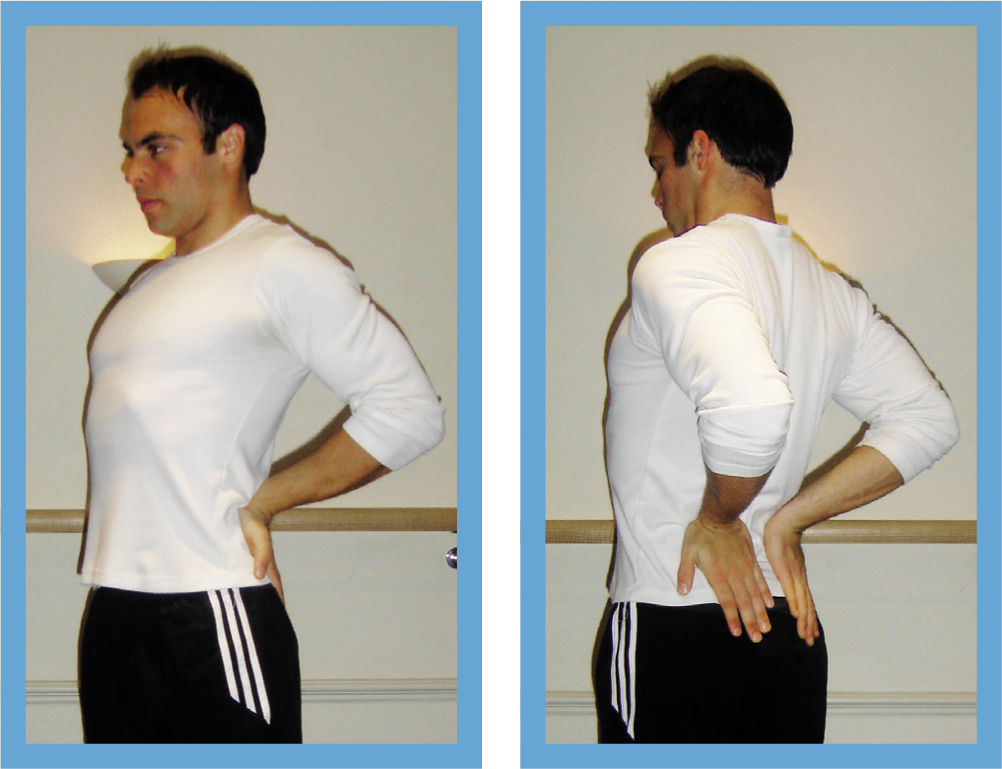
•Place your hands into the base of your spine.
•Bring your elbows as close together as possible and push your chest out. You should be able to feel a stretch in your chest (pectoral major, pectoral minor and anterior deltoid).
Static stretch for the chest on a wall
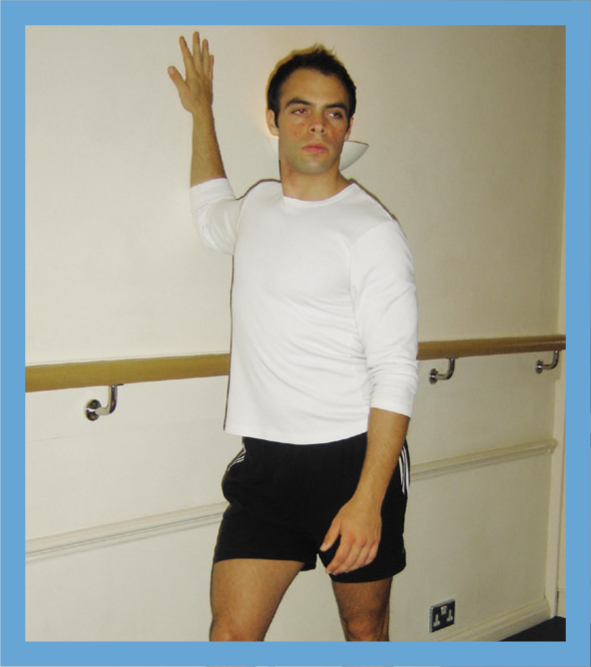
This is a postural stretch for the kyphotic posture.
•Stand beside a wall, with your feet shoulder-width apart.
•Bend your arm to a 90° angle at the elbow, and rest your forearm on to the wall or door frame.
•Place the same-side leg forwards.
•Turn your body and shoulders away from the bent arm until you feel a stretch in your chest (pectoral major, pectoral minor and anterior deltoid).
Static stretch for the lat muscle
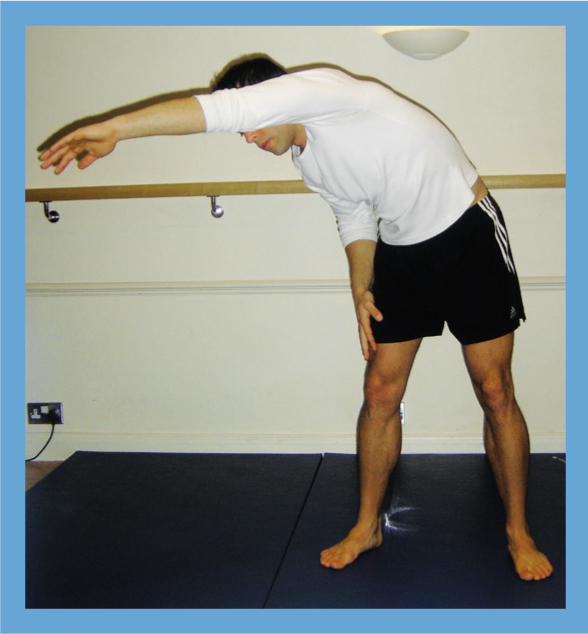
•Place your feet shoulder-width apart, and extend one arm across your body in front of you.
•Reach across as far as possible with your hands, while leaning slightly forwards. The key is to try and arch the side of your back.
•You can vary this by holding on to an object or doorway (this will give you a deeper stretch into the lat muscle). You should be able to feel a stretch in the side of your back (latissimus dorsi).
Static stretch for the rhomboid muscles
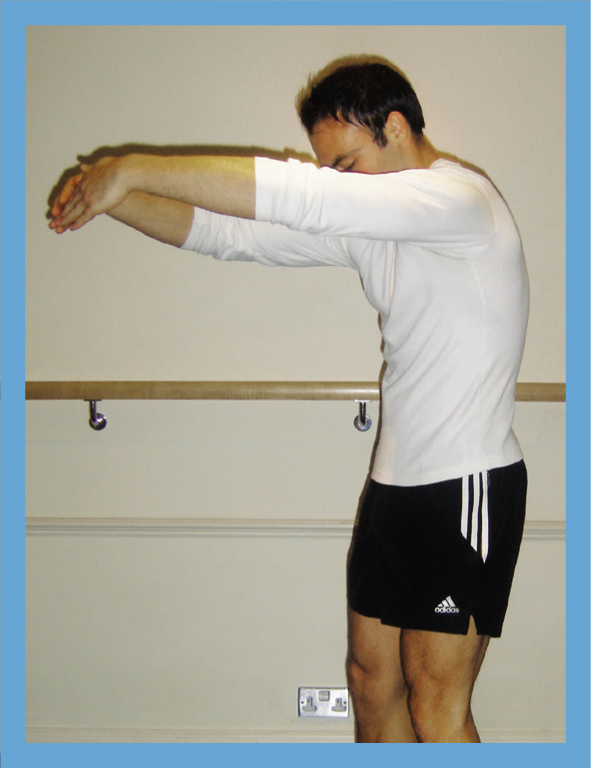
•Place your hands together in front of you at about shoulder height.
•Reach forwards as far as comfortable with your hands, trying to round the middle/upper part of your back. You should be able to feel a stretch in the middle of your upper back between your shoulder blades (rhomboids).
•It’s just like hugging a tree.
Static stretch for the trapezius muscles
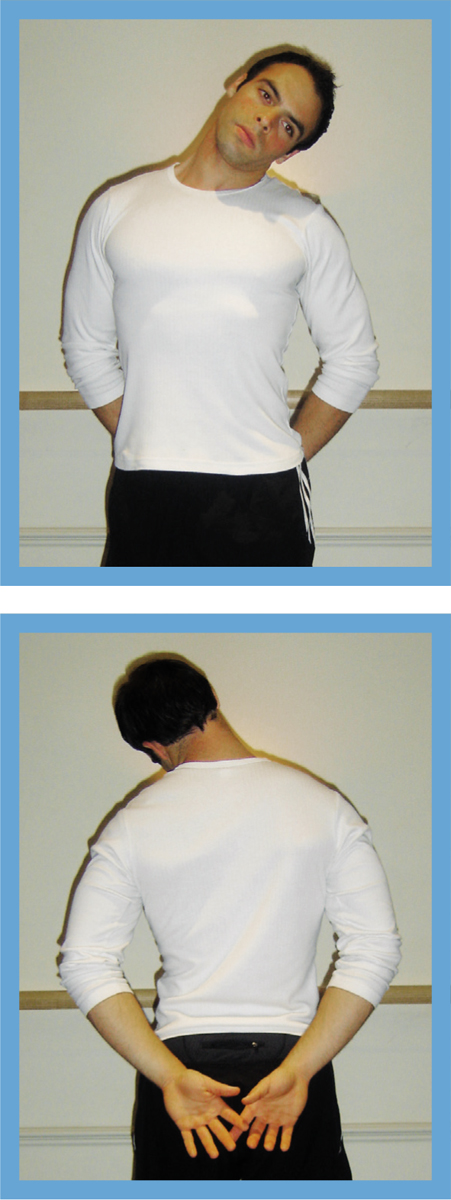
This can sometimes help kyphotic postures if you are feeling pain in the neck.
•While looking straight ahead, allow your head (ear) to drop towards the shoulder on the same side.
•Keep your hands behind your back to get the best stretch. You should be able to feel a stretch on the top of your shoulders into your neck (trapezius, levator scapulae).
Ending the myo stretch routine
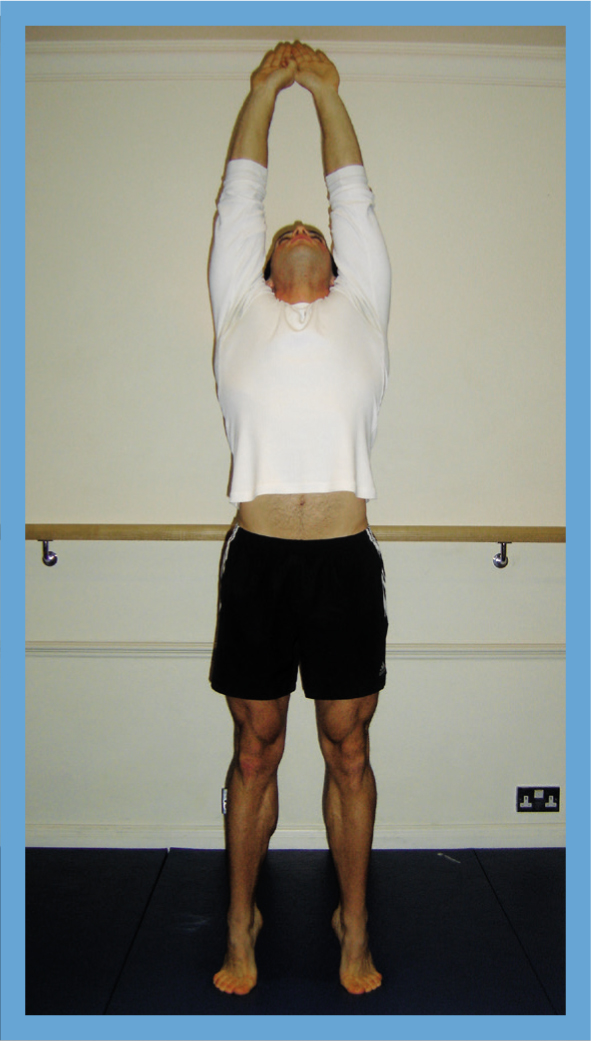
You have now completed the myo stretch routine and should feel relaxed, with no tension in your body.
To finish the routine, stand on your tiptoes and extend your arms overhead nice and straight. You should be able to feel a stretch throughout your body, and then release. Take a little walk around to get the blood moving throughout your whole body, including moving your arms.